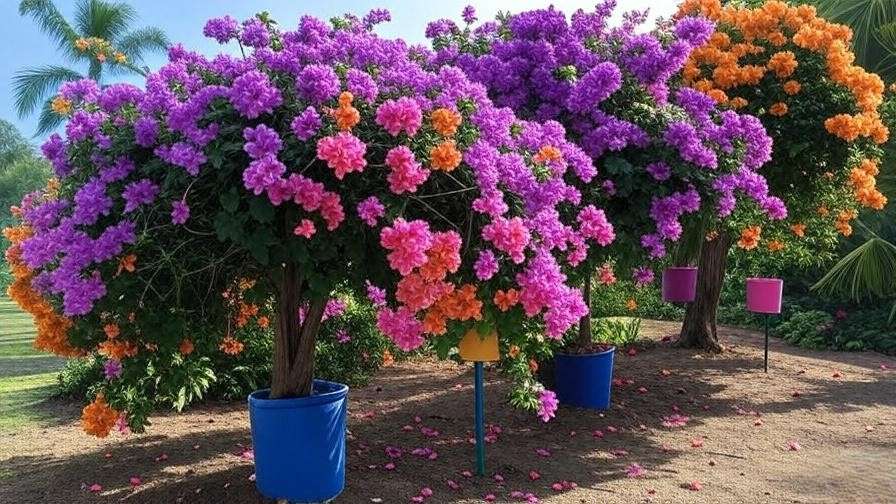Picture your garden bursting with cascades of vibrant pink, purple, and orange blooms, transforming your backyard into a tropical paradise. Bougainvillea trees, with their dazzling bracts and lush foliage, are the showstoppers of warm-climate landscapes. Yet, many gardeners struggle to unlock the full potential of these stunning plants, often facing sparse blooms or unhealthy growth due to common care mistakes. Whether you’re a seasoned horticulturist or a beginner, this comprehensive guide to bougainvillea trees will equip you with expert-backed tips to achieve vibrant, long-lasting blooms. Drawing on decades of horticultural expertise and insights from trusted sources like the University of Florida Extension, we’ll cover everything you need to grow thriving bougainvillea trees. 🌞
In this article, we’ll explore optimal growing conditions, planting techniques, essential care tips, troubleshooting advice, and creative landscaping ideas. By the end, you’ll have a clear roadmap to cultivate bougainvillea trees that steal the show in any garden. Let’s dive in and make your outdoor space bloom with color! 🌸
Understanding Bougainvillea Trees 🌸
What Are Bougainvillea Trees?
Bougainvillea trees aren’t true trees but woody, climbing shrubs (Bougainvillea spp.) often trained into a tree-like form through pruning and staking. Native to South America, these plants are celebrated for their colorful bracts—papery, petal-like structures that surround tiny white flowers. Popular species include Bougainvillea spectabilis, known for its vigorous growth, and Bougainvillea glabra, prized for smoother stems and compact size. Available in vibrant hues like magenta, red, orange, pink, and white, bougainvillea trees add a tropical flair to gardens worldwide. According to the Royal Horticultural Society, their adaptability has made them a staple in warm climates since their discovery in the 18th century by French botanist Philibert Commerson.
Why Choose Bougainvillea Trees for Your Garden?
Bougainvillea trees are a gardener’s dream for their low-maintenance care and high-impact beauty. They’re drought-tolerant, thrive in poor soils, and bloom profusely in the right conditions, making them ideal for busy homeowners or novice gardeners. Their versatility shines in various settings—trained as standalone trees, shaped into hedges, or grown in containers for patios. “Bougainvillea trees are a top pick for adding bold color with minimal effort,” says Dr. Maria Lopez, a horticulturist at the Miami Botanical Garden. Whether you’re aiming for a Mediterranean vibe or a tropical oasis, these plants deliver unmatched vibrancy. 🌿
Optimal Growing Conditions for Bougainvillea Trees ☀️
Climate and Hardiness Zones
Bougainvillea trees thrive in warm, sunny climates, ideally USDA hardiness zones 9–11, where temperatures rarely dip below 30°F (-1°C). They flourish in regions like Southern California, Florida, and the Mediterranean. In cooler zones (7–8), they can survive with protection, such as mulching or moving potted plants indoors during frost. For optimal growth, maintain temperatures above 60°F (15°C). If you’re in a marginal climate, choose cold-hardy cultivars like ‘Barbara Karst’ for better resilience.
Sunlight Requirements
Sunlight is non-negotiable for bougainvillea trees. They need at least 6–8 hours of direct sun daily to produce their signature vibrant blooms. Insufficient light is the leading cause of sparse flowering, a common complaint among gardeners. Position your bougainvillea in the sunniest spot available—south-facing locations are ideal. If grown in partial shade, expect more foliage and fewer blooms, which can disappoint those seeking a colorful display. ☀️
Soil Preferences
Bougainvillea trees prefer well-draining, slightly acidic soil with a pH of 5.5–6.5. Heavy clay soils can lead to root rot, so amend with sand, perlite, or organic matter like compost to improve drainage. “Good drainage is critical for bougainvillea success,” notes the University of Florida Extension. For container-grown plants, use a cactus or succulent potting mix to mimic their preferred conditions. Test your soil’s pH with a home kit and adjust with sulfur or lime if needed. 🪴
Planting Bougainvillea Trees: Step-by-Step Guide 🌳
Choosing the Right Location
Selecting the perfect spot is crucial for healthy bougainvillea trees. Choose a location with full sun and ample space, as these plants can spread 10–20 feet wide and tall if not pruned. Avoid planting near structures, as their thorny branches can cause damage or make maintenance tricky. Ensure the site has good air circulation to prevent fungal issues. For urban gardens, consider a corner spot where the plant can climb or spread without crowding other plants.
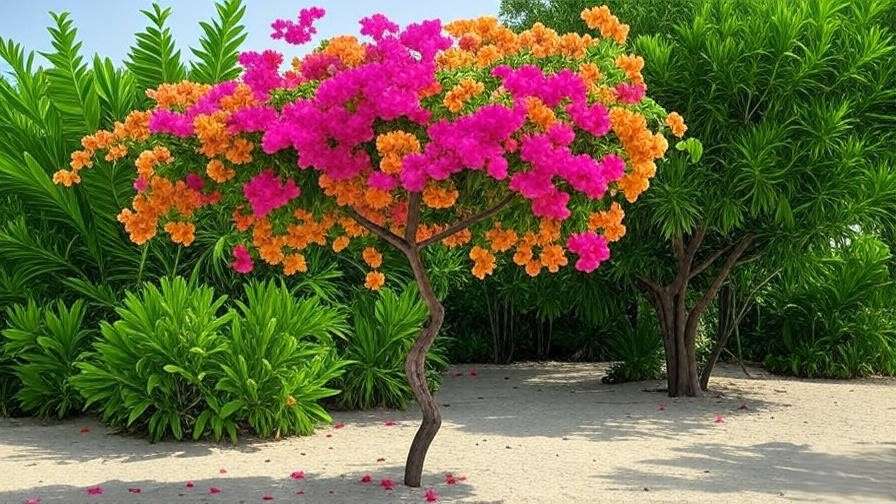
Planting Tips for Success
- Prepare the Site: Dig a hole twice as wide and as deep as the root ball. Mix compost or aged manure into the soil to boost nutrients.
- Position the Plant: Place the bougainvillea tree in the hole, ensuring the root ball’s top is level with the ground. For container plants, keep the soil line consistent.
- Backfill and Water: Fill the hole, tamp down gently, and water deeply to settle the soil.
- Mulch: Add a 2-inch layer of organic mulch (like bark) to retain moisture and suppress weeds, keeping it away from the stem to prevent rot.
A 2023 study from Texas A&M University emphasizes that proper root establishment during planting sets the stage for long-term vigor. For visual guidance, imagine a planting depth where the root ball sits snugly, with soil gently packed around it.
Container vs. Ground Planting
Ground Planting: Ideal for large landscapes, in-ground bougainvillea trees grow larger and require less frequent watering once established. They’re perfect for permanent fixtures like hedges or focal points.
Container Planting: Great for patios or colder climates, containers allow mobility to protect plants from frost. Use a pot at least 12–16 inches wide with drainage holes, filled with a well-draining mix. Containers limit growth, so they’re ideal for smaller spaces but require more frequent watering.
Pro Tip: Choose terracotta pots for breathability, but ensure they’re sturdy, as bougainvillea trees can become top-heavy. 🏺
Essential Care Tips for Vibrant Bougainvillea Trees 🌿
Watering Needs
Bougainvillea trees are drought-tolerant once established but need consistent moisture during their first year. Water deeply but infrequently—once every 7–10 days in summer, reducing to every 2–3 weeks in winter. Overwatering is a top mistake, leading to root rot or yellowing leaves. Check soil moisture by inserting a finger 2 inches deep; water only if dry. In hot climates, young plants may need weekly watering, while established ones thrive on rainfall alone in rainy seasons.
Seasonal Schedule:
- Spring/Summer: Water weekly, allowing soil to dry slightly between sessions.
- Fall/Winter: Reduce to biweekly or less, depending on rainfall.
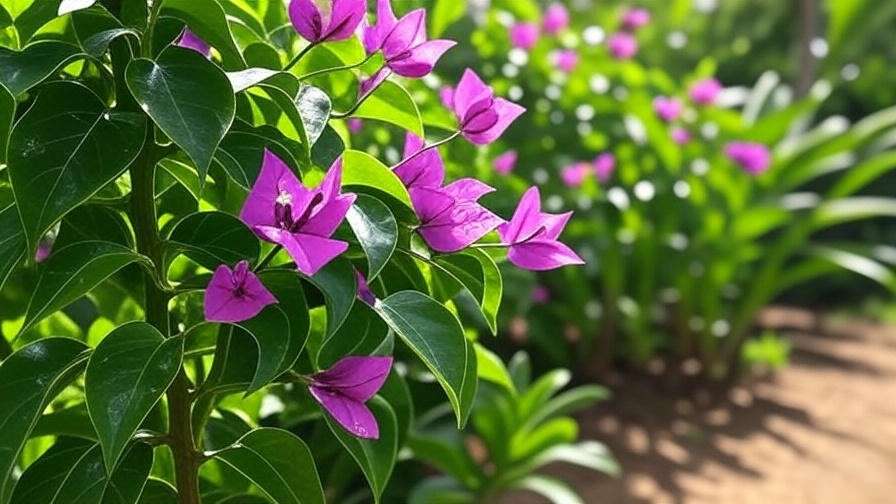
Fertilizing for Maximum Blooms
To achieve vibrant blooms, fertilize bougainvillea trees monthly during the growing season (spring–summer) with a balanced 10-10-10 fertilizer or a bloom-boosting formula high in phosphorus (e.g., 5-10-5). Avoid high-nitrogen fertilizers, which promote leafy growth at the expense of flowers. Apply granular fertilizer around the plant’s drip line or use a water-soluble option for containers. “Phosphorus is key to prolific blooming,” advises Dr. Lopez. Stop fertilizing in fall to let the plant rest. 🌼
Pro Tip: Dilute liquid fertilizers to half-strength to prevent burn, and always water after applying to distribute nutrients.

Pruning and Training Bougainvillea Trees
Pruning is essential to shape bougainvillea trees and encourage blooming. Prune in late winter or early spring before new growth begins. Use sharp, clean shears to remove dead or crossing branches and shape the plant into a tree form by staking the main stem. Cut back long shoots to 6–8 nodes to stimulate flowering. Wear thick gloves to protect against thorns.
Training Tip: Use a sturdy stake or trellis to guide young plants into a tree shape. Tie loosely with soft ties to avoid damaging stems. For visual inspiration, picture a neatly trimmed bougainvillea with a single trunk and a rounded canopy bursting with color.
Pest and Disease Management
Common pests include aphids, spider mites, and caterpillars, which can be managed with neem oil or insecticidal soap. Check leaves regularly for sticky residue or webbing. Fungal leaf spot, caused by excess moisture, appears as black spots on leaves. Improve air circulation and avoid overhead watering to prevent it. For severe cases, use a copper-based fungicide, following Integrated Pest Management (IPM) guidelines from Cornell University. Regular monitoring keeps issues at bay. 🐞
Troubleshooting Common Bougainvillea Tree Problems 🐛
Why Aren’t My Bougainvillea Trees Blooming?
Lack of blooms frustrates many gardeners. Common causes include:
- Insufficient Sunlight: Ensure 6–8 hours of direct sun.
- Over-Fertilization with Nitrogen: Switch to a phosphorus-rich fertilizer.
- Improper Pruning: Avoid cutting new growth, where buds form.
Checklist:
- Verify sunlight exposure.
- Test soil nutrients with a kit.
- Prune strategically in late winter.
Expert Insight: A 2022 study from the University of California noted that slight drought stress can trigger blooming, so avoid overwatering mature plants.
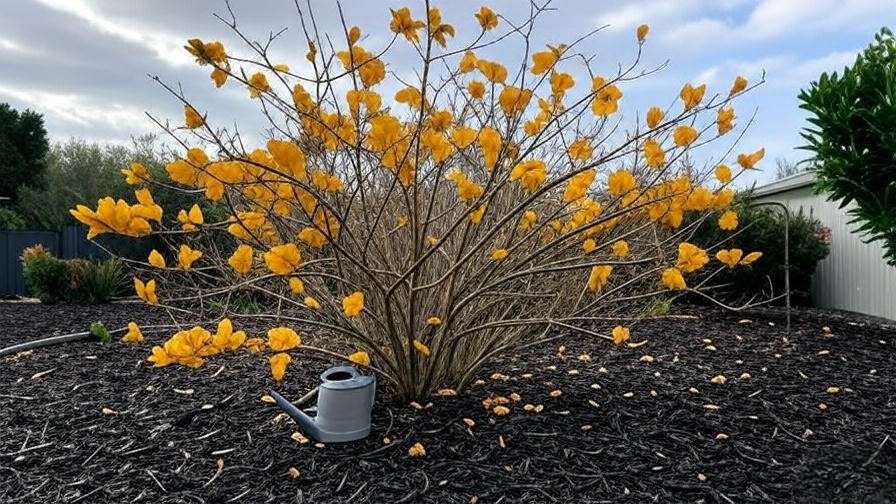
Yellowing Leaves or Dropping Bracts
Yellow leaves often signal overwatering, nutrient deficiencies, or transplant shock. Test soil moisture and reduce watering if soggy. Apply a balanced fertilizer or iron chelate for chlorosis (yellowing due to iron deficiency). Dropping bracts may occur after transplanting or environmental changes; ensure stable conditions to minimize stress.
Winter Care for Bougainvillea Trees
In zones below 9, protect bougainvillea trees from frost by:
- Mulching: Add a 3-inch layer of mulch around the base.
- Covering: Use frost cloth on cold nights.
- Moving Containers: Bring potted plants indoors or to a sheltered area.
Success Story: Jane, a gardener in Arizona, overwintered her potted bougainvillea by placing it in a sunny garage, resulting in vibrant blooms the following spring.
Creative Uses for Bougainvillea Trees in Landscaping 🎨
Bougainvillea trees are a landscaper’s dream, offering endless possibilities to elevate your garden’s aesthetic. Their vibrant bracts and versatile growth habits make them perfect for creating eye-catching focal points or lush backdrops. Here are some creative ways to incorporate bougainvillea trees into your outdoor space:
- Standalone Tree: Train a bougainvillea into a single-trunk tree for a dramatic centerpiece. Stake the main stem and prune lower branches to create a canopy bursting with color. This works beautifully in small yards or courtyards, adding height and vibrancy without overwhelming the space.
- Hedges or Privacy Screens: Plant multiple bougainvillea trees in a row and prune them into a dense hedge. Their thorny branches deter intruders, while the colorful bracts provide a stunning visual barrier. Ideal for poolside areas or property lines.
- Container Gardens: Grow bougainvillea trees in large pots to brighten patios, balconies, or entrances. Pair with trailing plants like petunias or cascading herbs for a layered look. Containers also allow flexibility in colder climates, where plants can be moved indoors during winter.
- Arbors and Trellises: Let bougainvillea trees climb over arbors, pergolas, or fences for a romantic, Mediterranean-inspired vibe. Their sprawling growth creates a natural canopy, perfect for shading outdoor seating areas.
Design Tip: Pair bougainvillea trees with complementary plants like lavender, hibiscus, or agave to enhance texture and color contrast. For example, a purple bougainvillea tree alongside silver-gray agave creates a striking desert-inspired look.
Case Study: Landscape designer Emma Carter transformed a bland backyard in San Diego into a tropical oasis by planting ‘Raspberry Ice’ bougainvillea trees along a trellis. The vibrant pink bracts contrasted beautifully with white roses, earning praise from clients and local garden tours. “Bougainvillea trees bring unmatched drama to any design,” Carter notes. 🌿
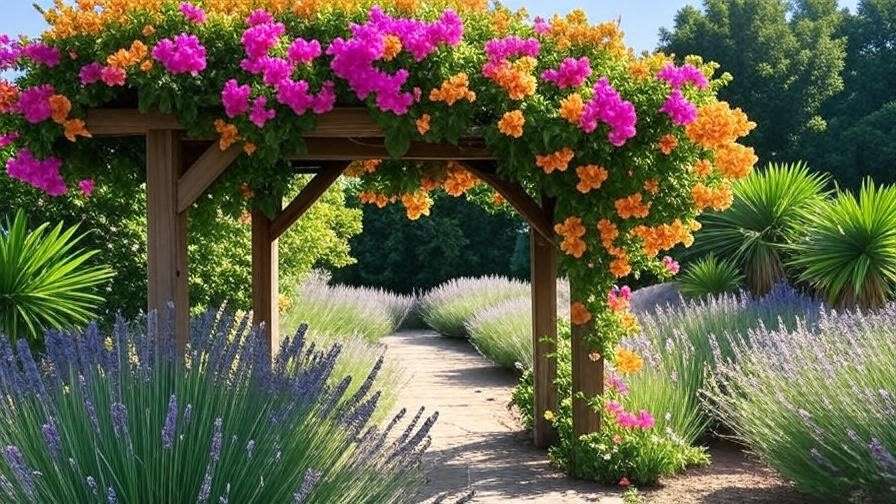
FAQs About Bougainvillea Trees ❓
To address common reader queries and boost SEO value, here are answers to frequently asked questions about bougainvillea trees, aligned with search intent:
How fast do bougainvillea trees grow?
Bougainvillea trees grow 1–2 feet per year under ideal conditions (full sun, well-draining soil, and regular care). Growth is fastest in warm climates with consistent watering during the establishment phase. Pruning can control size and encourage bushier growth. For faster results, choose vigorous cultivars like ‘San Diego Red.’
Are bougainvillea trees toxic to pets?
Bougainvillea trees are mildly toxic to pets if ingested, causing digestive upset in dogs or cats. Their thorny branches also pose a risk of injury. Keep pets away from fallen bracts and monitor for chewing. The ASPCA lists bougainvillea as non-toxic in small amounts, but caution is advised. 🐶
Can bougainvillea trees survive frost?
Bougainvillea trees are frost-sensitive and may suffer damage below 30°F (-1°C). In zones 7–8, protect them with mulch, frost cloth, or indoor relocation for potted plants. In severe winters, expect some leaf drop, but healthy plants often recover in spring.
How do I propagate bougainvillea trees?
Propagate bougainvillea trees via stem cuttings in spring or summer:
- Take 6–8-inch semi-hardwood cuttings with 3–4 nodes.
- Remove lower leaves and dip the cut end in rooting hormone.
- Plant in a mix of perlite and peat moss, keeping it moist and warm.
- Roots form in 4–8 weeks under bright, indirect light.
This method is cost-effective and allows you to expand your garden with new plants. 🌱
Expert Tips for Long-Term Success with Bougainvillea Trees 🌟
To elevate your bougainvillea tree care, here are advanced tips from horticultural experts:
- Stress-Induced Blooming: Induce vibrant blooms by slightly stressing the plant with controlled drought. Once established, reduce watering to once every 2–3 weeks during the growing season. “A little stress encourages bougainvillea to bloom profusely,” says Dr. Maria Lopez, horticulturist at the Miami Botanical Garden.
- Staking for Tree Form: To maintain a tree shape, use a sturdy 6-foot stake driven 12 inches into the soil. Tie the main stem loosely with soft ties, checking annually to prevent constriction. This ensures a strong, upright structure.
- Seasonal Maintenance: In spring, remove winter-damaged branches and apply a slow-release fertilizer. In fall, reduce watering and skip fertilization to prepare the plant for dormancy.
- Community Engagement: Join local gardening clubs or online forums like the GardenWeb Bougainvillea Community to share tips and troubleshoot issues. Connecting with other enthusiasts boosts your knowledge and confidence.
Expert Quote: “Bougainvillea trees reward patience with unparalleled beauty. Consistent care and strategic pruning unlock their full potential,” says John Rivera, a nursery owner with 25 years of experience in tropical plants.
Conclusion
Bougainvillea trees are a stunning addition to any garden, offering vibrant blooms and low-maintenance care when grown correctly. By providing full sun, well-draining soil, and proper pruning, you can transform your landscape into a colorful masterpiece. This guide has covered everything from planting and care to troubleshooting and creative landscaping ideas, ensuring you have the tools to succeed. Whether you’re aiming for a single showstopping tree or a vibrant hedge, bougainvillea trees deliver unmatched beauty with the right approach. 🌺
Ready to grow your own bougainvillea trees? Apply these tips and watch your garden come alive with color. Share your success stories in the comments below, and explore our related articles on tropical plant care for more inspiration. For additional resources, check out trusted sources like the University of Florida Extension or the Royal Horticultural Society. Happy gardening! 🌞

